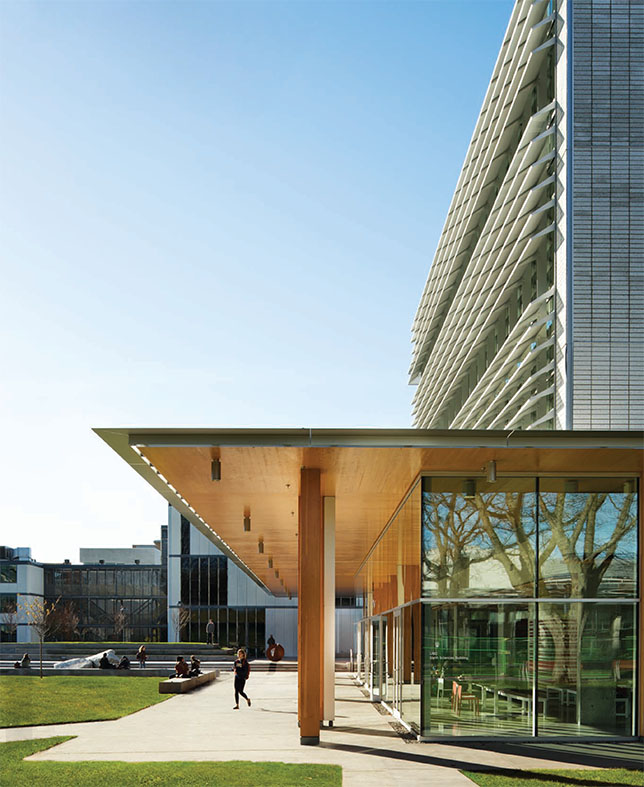An estimated 25 million birds die in collisions with windows in Canada each year. Residential homes and low-rise buildings are responsible for the majority of such deaths, but many birds also perish on university campuses. As awareness of the threat spreads, several Canadian universities have taken measures to mitigate the damage.
In 2019, York University became one of the first campuses in Canada to apply a type of bird-safety film on the windows of key buildings. The move came after a three-year lobbying campaign led by biology professor Bridget Stutchbury and her students. Dr. Stutchbury explains that birds are vulnerable to collisions because glass does not exist in their natural environment. As a result, they may mistake the reflection of trees and vegetation in the glass for the real thing and fly to their deaths trying to reach them.
Dr. Stutchbury estimates that about 2,000 birds die in collisions with windows annually at the Keele campus in Toronto but it took physical evidence of the carnage to convince university officials of the need for change. “My grad students spent hundreds of hours collecting and cataloguing the dead birds. We went to the administration and said, ‘Here’s how many birds have died and here are their photos.’”
In response the university spent $90,000 to buy and install bird-friendly dot patterns at five of the deadliest sites on campus. Since then, two more sites have been modified.

“There was a night-and-day difference after the [window] treatment,” Dr. Stutchbury noted. In the fall of 2019, before the coverings were installed, the professor reported finding 68 dead and injured birds at four “problem sites.” After the window treatments had gone up, her team only found one casualty at these same locations.
Efforts to install bird-friendly windows at the University of Ottawa grew out of a collaboration between Safe Wings Ottawa – a group that aims to reduce bird deaths from window collisions through research, prevention and rescue – and the university’s office of campus sustainability. The university is now incorporating bird-friendly etched or fritted glass in its new buildings and retrofitting windows on some of its older buildings. Jonathan Rausseo, senior specialist with the office of campus sustainability at U of Ottawa, says that members of his staff and student volunteers worked for several years at determining the best methods to affix bird-friendly designs on older buildings.
“We spent a lot of time navigating the university bureaucracy, getting approval for designs and experimenting with different techniques,” Mr. Rausseo said. They finally settled on murals created by local student-artists and a team of volunteers, who paint the designs on the glass with white Sharpies. “It’s the cheapest and fastest option,” he said.
The university’s first bird-friendly mural, a design featuring a blend of birds and vegetation, was applied in 2021 to a suspended glass corridor that links two buildings. The second, depicting alternative energy systems, was painted on a glass passageway at the engineering building in 2022. Both sites were selected due to the high risk they represent for collisions. A third mural will soon be added at another site.
“I’m happy with what we’ve done,” said Mr. Rausseo. “At the very least … that takes care of most of the first- and second-storey windows on campus. Studies show this is where the highest number of collisions occur because these windows reflect the trees and vegetation.”
At the University of British Columbia, a move to ensure that all new glass-sided buildings must include bird-friendly designs was adopted in response to the shocking results of a survey led by Krista De Groot, a biologist with Environment and Climate Change Canada’s Canadian Wildlife Service. The study revealed that 152 birds died over 225 days due to bird strikes at eight randomly selected buildings on UBC’s Vancouver campus. Since there are 224 similar buildings on the sprawling campus, the annual mortality here may be as high as 10,000 birds per year.
All new campus buildings at UBC are now required to feature bird-friendly designs as outlined by a Green Building Action Plan that was approved in 2018. The policy took effect in 2020 for new academic and administrative buildings and will apply to new residential buildings by 2025.
“Additionally, UBC is working with partners on and off campus through the SEEDS Sustainability Program to research bird collisions on campus by monitoring buildings for bird strikes. Through this work we are discovering which buildings are most dangerous for birds, and gradually they can be retrofitted,” said Penny Martyn, UBC’s green building manager.
To date, the UBC Botanical Garden Pavilion, the Buchanan Building and the Beaty Biodiversity Centre have added bird-friendly designs to their windows. However, finding funds to initiate future changes remains a challenge. One site under consideration for a retrofit, an aerial boardwalk, consists of 170 separate glass surfaces.
A wonderful idea, but I’d like to add a caveat before readers rush out to stick owl decals to their office windows (almost worthless) – many of the available “solutions” are of little to no actual value. Decals applied to the inside of windows are approximately useless against reflection-based collisions. Murals applied to the outside of the window are better, though need to be weather-resistant. Overhangs as in the article’s illustration can be excellent if the environment is taken into account – they don’t work well as well against strikes coming from nearby low shrub, but are great in a more open area.
There is little research done on this subject, but one solution shown to be broadly effective are so-called “Acopian birdsavers”, vertical cords suspended just outside “problem” windows. They can be easily and cheaply made by anyone, and in my own (residential) experience they reduced collisions from twice-weekly during high season to a single mild strike in three years.
There’s a US company that makes them also, that I have nothing to do with. I just find these are the cheapest and most effective solution, at least for retrofits.